ATIA 2020 Gadget Roundup

Posted by Eliza J. Anderson – Reprint from AT3 Center News & Tips
7 tools and toys exhibited at the Assistive Technology Industry Association (ATIA) expo (plus two that should have been there).
In the spirit of a Consumer Electronics Show (CES) tech review–minus the pop-ups and accessibility problems!–here is a roundup of 7 tools and toys from ATIA 2020. Most are on the market, some are still in beta, all are listed without implied endorsement. Number eight is a device from CES that should have been at ATIA. Number nine is a device that would probably do well at both ATIA and CES … designed for this frightened digital age.
One: Sunu Band and App
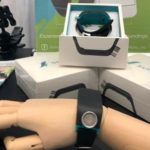 Sunu Band takes advantage of a small sonar sensor to provide haptic (tactile) feedback to users with vision impairments. Cool! At ATIA, Sunu was also promoting its new wayfaring app, which pairs with the device, though each may be used separately. The wayfaring app is not yet available on their website.
Sunu Band takes advantage of a small sonar sensor to provide haptic (tactile) feedback to users with vision impairments. Cool! At ATIA, Sunu was also promoting its new wayfaring app, which pairs with the device, though each may be used separately. The wayfaring app is not yet available on their website.
Sunu Band pulses vibrations of varying lengths when it senses an obstacle. It is designed to assist users with navigating crowds and avoiding obstacles to the upper body. Unlike the WeWalk smart cane, it is not cane or smartphone-dependent. I found it has a learning curve because it was very hectic (and thus haptic) in the busy exhibition hall.
Two: TiPY Keyboard
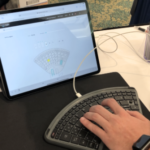 The TiPY one-handed keyboard launched this month. It’s a beautiful device that’s double-sided so users may choose left or right-handed typing.
The TiPY one-handed keyboard launched this month. It’s a beautiful device that’s double-sided so users may choose left or right-handed typing.
TiPY can be wired or wireless, supports multiple languages, and integrates the mouse function. It comes with an app that teaches users how to type with TiPY’s keyboard configuration.
Watch the video: TiPY promotional video (no audio description).
Three: Smyle Mouse
Now it’s not only possible to control your computer with your head and face, it’s also possible to do so without specialized hardware or putting stickers on your face! Smyle Mouse software uses your computer’s webcam, allowing you to point, click, drag and scroll with precision using just your head, your smile and your eyebrows. The software also provides an adaptive switch mode and eye-tracking options. Smyle Mouse is compatible with Windows 7 and above. Check out the video below (silent except for audio description).
Four: HouseMate
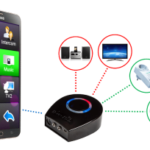 HouseMate (a product of Ireland) is an environmental control unit (think smart home hub) that is designed specifically for individuals with disabilities rather than the mainstream consumer market. HouseMate can work without wifi or the internet to control conventional appliances and consumer tech smart home gadgets. HouseMate works with, and provides access to, Android and iOS mobile devices, and provides Bluetooth mouse access to PCs as well. Back up power and alarm safety features are integrated.
HouseMate (a product of Ireland) is an environmental control unit (think smart home hub) that is designed specifically for individuals with disabilities rather than the mainstream consumer market. HouseMate can work without wifi or the internet to control conventional appliances and consumer tech smart home gadgets. HouseMate works with, and provides access to, Android and iOS mobile devices, and provides Bluetooth mouse access to PCs as well. Back up power and alarm safety features are integrated.
Users connect through HouseMate’s built-in switch, external switches, joysticks (including common power chair joysticks) or via voice. HouseMate includes Z-Wave Direct and Infrared radio signals. No one is listening, eliminating HIPPA and other privacy or identity concerns. Significantly, it can be used at home, school, work or traveling since it’s not wifi network dependent (though wifi is an option). Here’s a HouseMate video overview (not audio described).
Five: Zerotie
Zerotie shoes are an affordable no-tie sneaker option for men, women, and children. Step into the shoe and pull back on your heel to tighten the laces with an embedded small plastic wheel. Loosening is accomplished by stepping on a lever attached to that wheel using your other foot.
I held the shoe and found it very solidly built with an impressive tread. I wondered about that wheel’s longevity in the mud and dirt of rural living. City dwellers, likely, have no problem. The Zerotie looks like a less-techy, more affordable option to the Nike Hyperadapt.
Six: Cognixion Speakprose Pro+ App
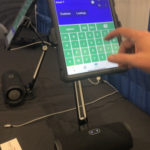 Speakprose Pro+ is a communication app (AAC) for iPad Pro and iPhone X that may be accessed via eye-tracking and facial movements. Or users can tap the text-based interface and swipe gestures for fast message selection. The app is best suited for literate persons who are new to AAC and wish to get communicating quickly. Highly customizable and very fast and easy to calibrate.
Speakprose Pro+ is a communication app (AAC) for iPad Pro and iPhone X that may be accessed via eye-tracking and facial movements. Or users can tap the text-based interface and swipe gestures for fast message selection. The app is best suited for literate persons who are new to AAC and wish to get communicating quickly. Highly customizable and very fast and easy to calibrate.
Cognixion is a company to watch. They are currently working on a brain control interface so users can communicate via brain waves (using a headband). Speakprose Pro+ is available as a subscription. Hardware and software bundles are also available to buy and with different levels of support and training.
The Speakprose Pro+ version on display at ATIA additionally integrated the Alexa voice assistant. My video, below, demonstrates this feature and the bizarre weather she predicted for Orlando, Florida (not sure why that happened!) This, I believe, is a beta feature, as it’s not advertised on the website. The video is captioned and described.
Seven: Skoogmusic
Skoogmusic is an accessible way to learn to play music as well as play along with a favorite band (without having to learn music). The squishy rubberized box has color-coded smushy button sides that activate notes with an external speaker.
The Skoog teaches melodies with a simple app interface. Different instrument sounds may be selected and the app can pair with playlist options such as Spotify, allowing users to jam with their favorite bands. The software calibrates Skoog to the key of whatever song is queued to play. To understand the play-along feature and other Skoog capabilities, check out this Getting Started with Skoog Vimeo. My audio-described video below demonstrates learning to play Itsy Bitsy Spider by color with the Skoog app.
Eight: Lexilight
 Lexilight is a lamp designed for people with dyslexia that reportedly makes reading easier. The lamp was developed in response to new research conducted in France that concluded people with dyslexia see differently because they do not have a single “dominant eye.” Lexilamp overcomes this problem with customizable pulsing LEDs that get the brain processing information as though from a single dominant eye.
Lexilight is a lamp designed for people with dyslexia that reportedly makes reading easier. The lamp was developed in response to new research conducted in France that concluded people with dyslexia see differently because they do not have a single “dominant eye.” Lexilamp overcomes this problem with customizable pulsing LEDs that get the brain processing information as though from a single dominant eye.
It could have been wonderful to see and discuss this lamp at ATIA with various colleagues with dyslexia. Alas, it was not there.
Nine: Paranoid
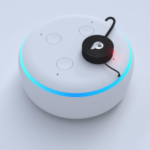 A Google Home smart speaker with the Paranoid Home Button. Paranoid was not at ATIA 2020 but would have attracted attention.
A Google Home smart speaker with the Paranoid Home Button. Paranoid was not at ATIA 2020 but would have attracted attention.
Yes, this is the name of a Canadian tech company whose mandate is “To earn lots of money increasing privacy not eroding it.” Their site advertises three products for use with smart speakers. The devices affix to or are installed within Amazon Echo or Google Home to disrupt their listening. Paranoid adds a voice-controlled layer of protection. First, you say “Paranoid,” then you say “Hey Google…” It’s kind of like those two-layer verification security protocols…
Every ATIA workshop I attended made reference to privacy concerns. Attendees working in school districts raised them as well as those working with veterans and others. The market is demanding more security and privacy. In the meantime, here comes Paranoid.

